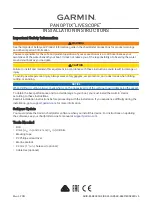
P Z 2 - 4 T h r u P Z 2 - 1 6
Installation
3
INTRODUCTION TO OZONE
Ozone (O
3
) is generated by irradiating air or oxygen (O
2
) with ultraviolet radiation. Ozone is a molecule of oxygen that is formed when
three atoms of oxygen are bound together instead of the normal two atoms. The extra oxygen atom makes ozone the most powerful
oxidizer and sanitizer readily available.
Since ozone is unstable and quickly decomposes to normal oxygen under normal conditions, it cannot be shipped or stored. Therefore,
it must be manufactured on site for immediate use. In normal air it lasts about an hour. In normal pool water it lasts just long enough to
purify the water - less than 1 second.
Although ozone is mainly thought of as a sanitizer, it acts primarily as an oxidizer in the pool environment. In a typical pool run on
chlorine only, up to 90 percent of the chlorine may be used up in reactions unrelated to disinfection. The byproducts of these reactions
are combined chlorines. Combined chlorines are the cause of eye irritation, odor, and the other unpleasant side effects of chlorination.
When ozone is used, it oxidizes a large portion of the contaminants (usually referred to as bather load) which result in the formation of
combined chlorines. The result is that more chlorine is available for disinfection and less chlorine is required to maintain the pool.
Ozone also provides some disinfection, but an ozone residual cannot be established, so the use of chlorine or bromine is always
recommended.
PREPARING FOR INSTALLATION
1. Install your PZ2 Ozonator so that dust, sand, debris, chemicals, or other foreign objects are not sucked into the
compressor's intake fan or hose (if equipped with Noise Attenuator).
2. Check electrical system: 240VAC double switched per N.E.C. standards; 120VAC single switched.
3. Check for Suction Line Check Valve. Equipment may draw if no check valve is present.
4. Balance the pH.
5. Backwash the filter.
6. Shock the pool with a non-lithium-based material. The use of Calcium Hypochlorite or Sodium Hypochlorite is recommended.
The Table below summarizes the levels that are recommended by The Association of Pool and Spa Professionals
(APSP). It is important to maintain these levels in order to prevent corrosion or scaling and to ensure maximum enjoyment
of the pool. Test your water periodically. Take a water sample in to be professionally tested by a Pool and Spa
Professional at least once a month. See our web site for more information on Basic Pool Water Chemistry.
pH
7.2 – 7.6
Alkalinity
80 – 120 ppm
TDS
< 1,000
Cyanuric Acid
30 – 70 ppm
Free Chlorine
0.5 – 1.5 ppm
Calcium Hardness
60 – 400 ppm
Metals
0 ppm
Nitrates / Phosphates
< 30 ppm
INSTALLATION
NOTE:
The instructions in this document provide general installation guides. Consult your dealer for specific installation instructions.
Additional information is available at www.prozoneint.com. Check system for any visible shipping damage. If damage has occurred,
contact the delivery company and your dealer immediately. Before beginning installation, please turn to the Installation Kit Inventory
Section and verify that all listed parts are on hand.
Tools Needed
: Cordless Power Drill, Screw Driver, Adjustable Wrench, Pliers, Wall Mount Screw Anchors, Knife























